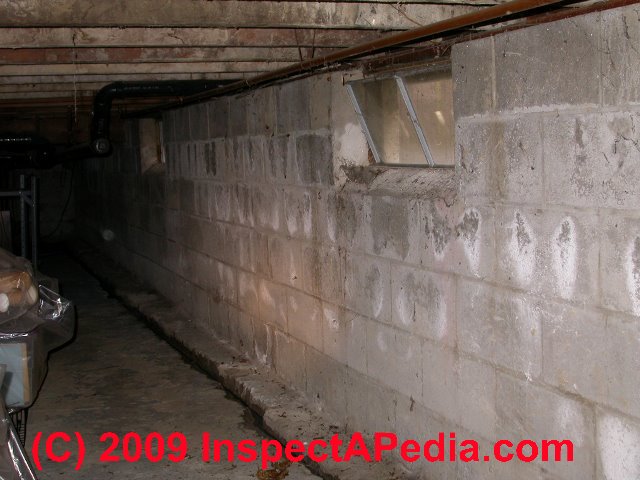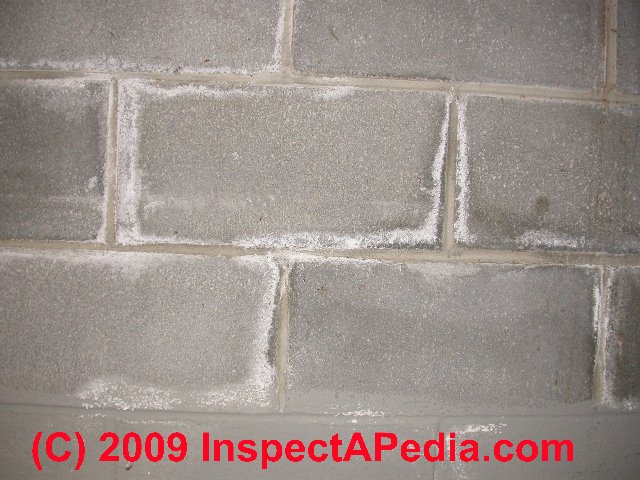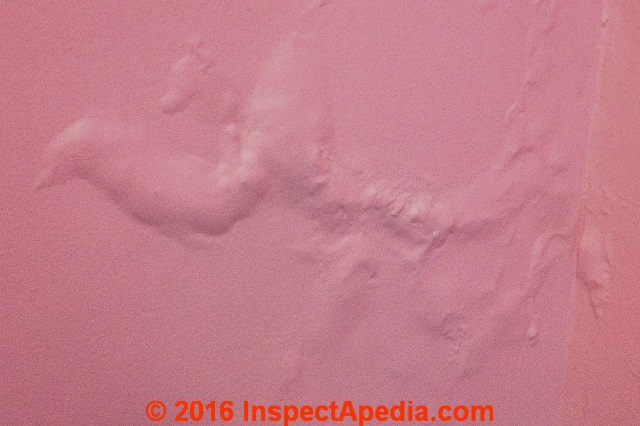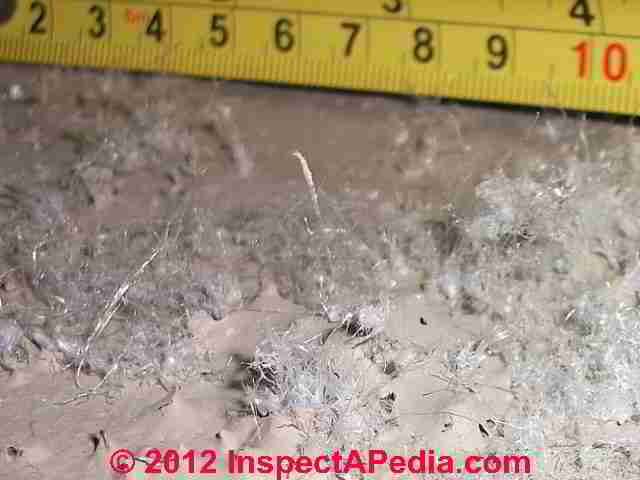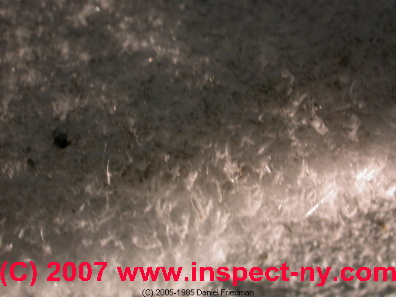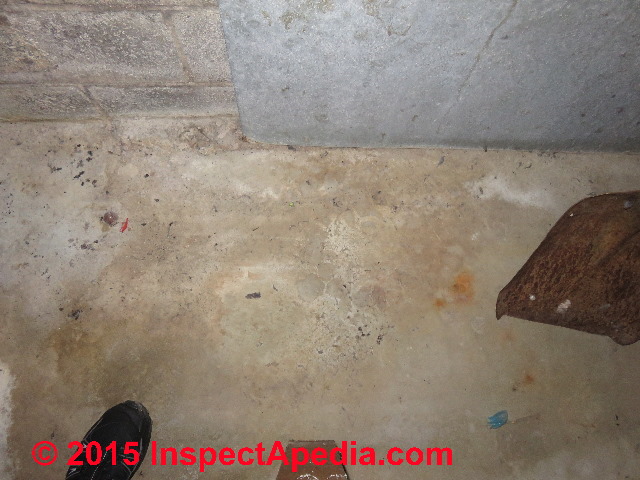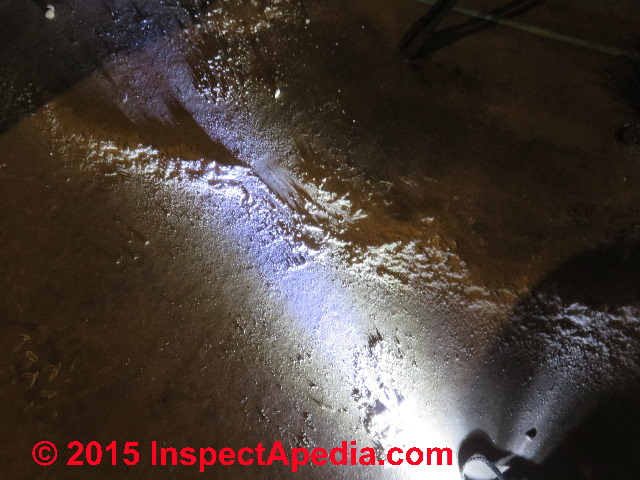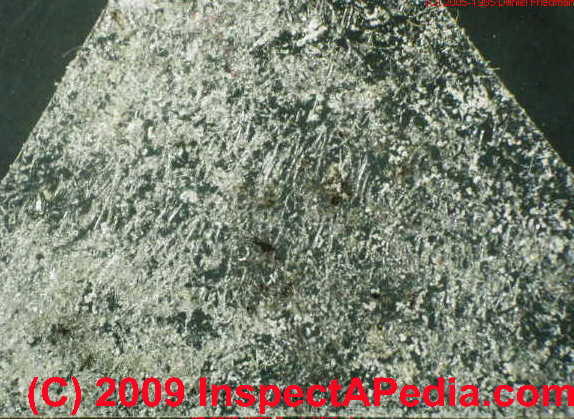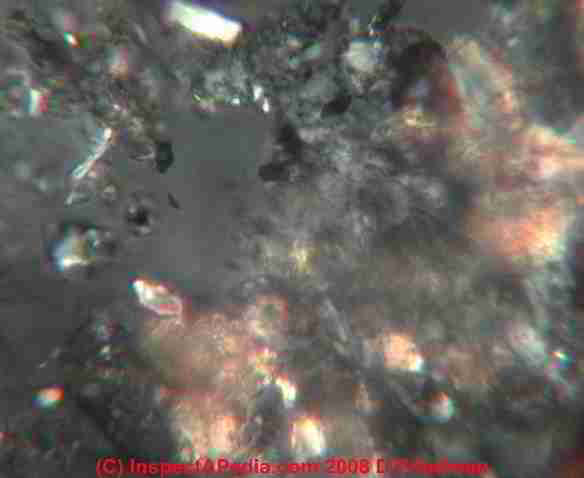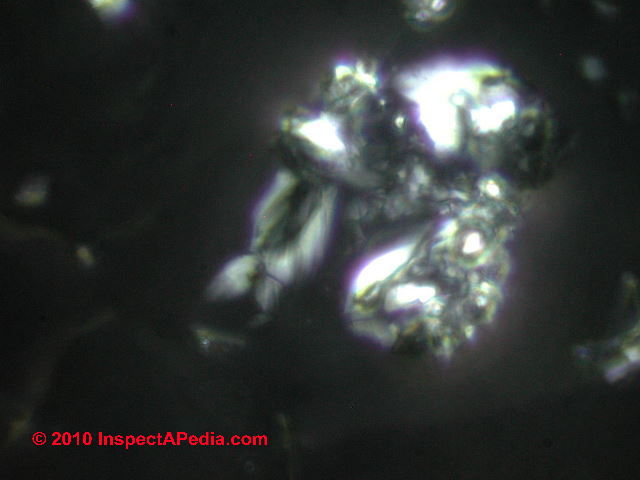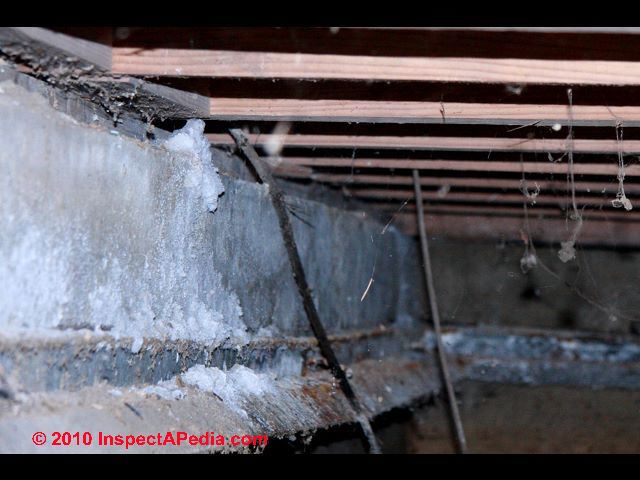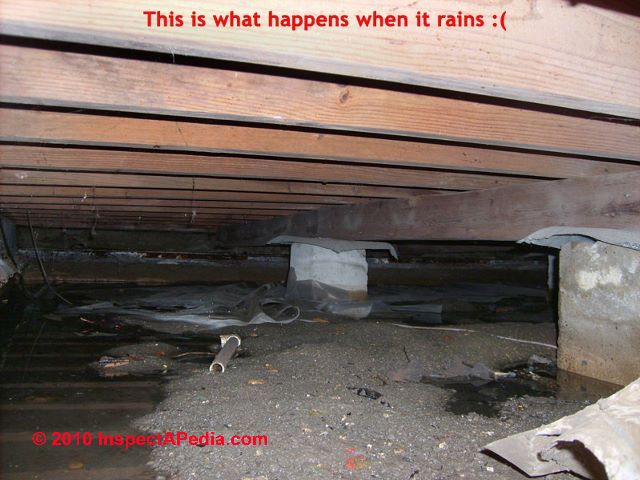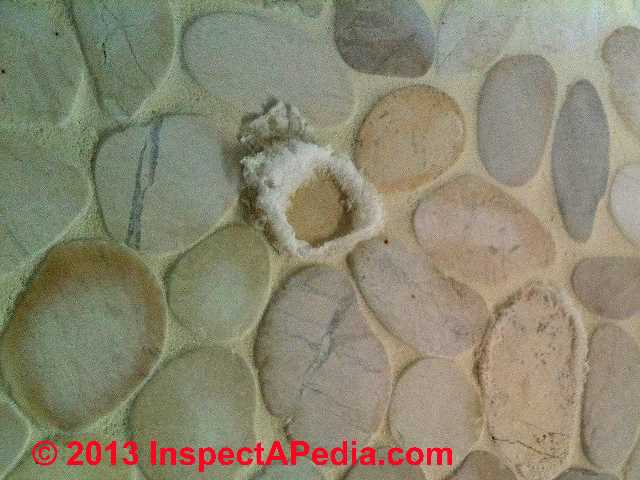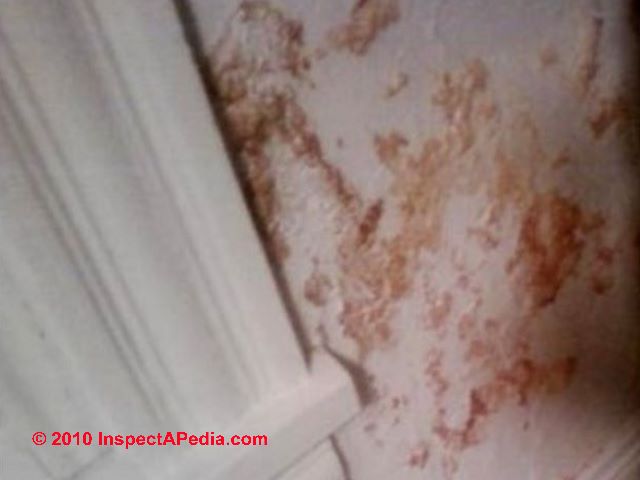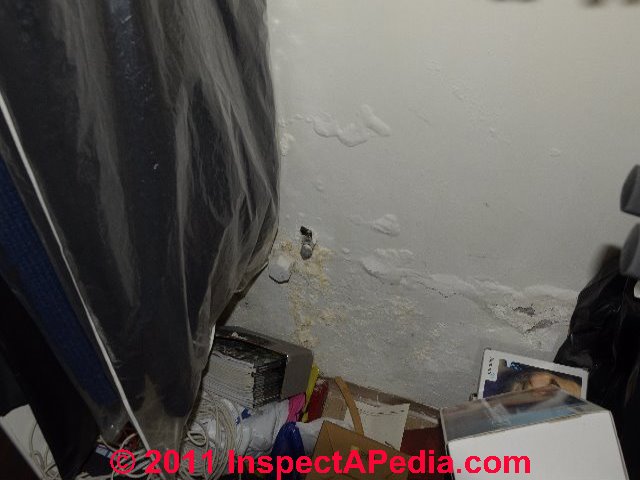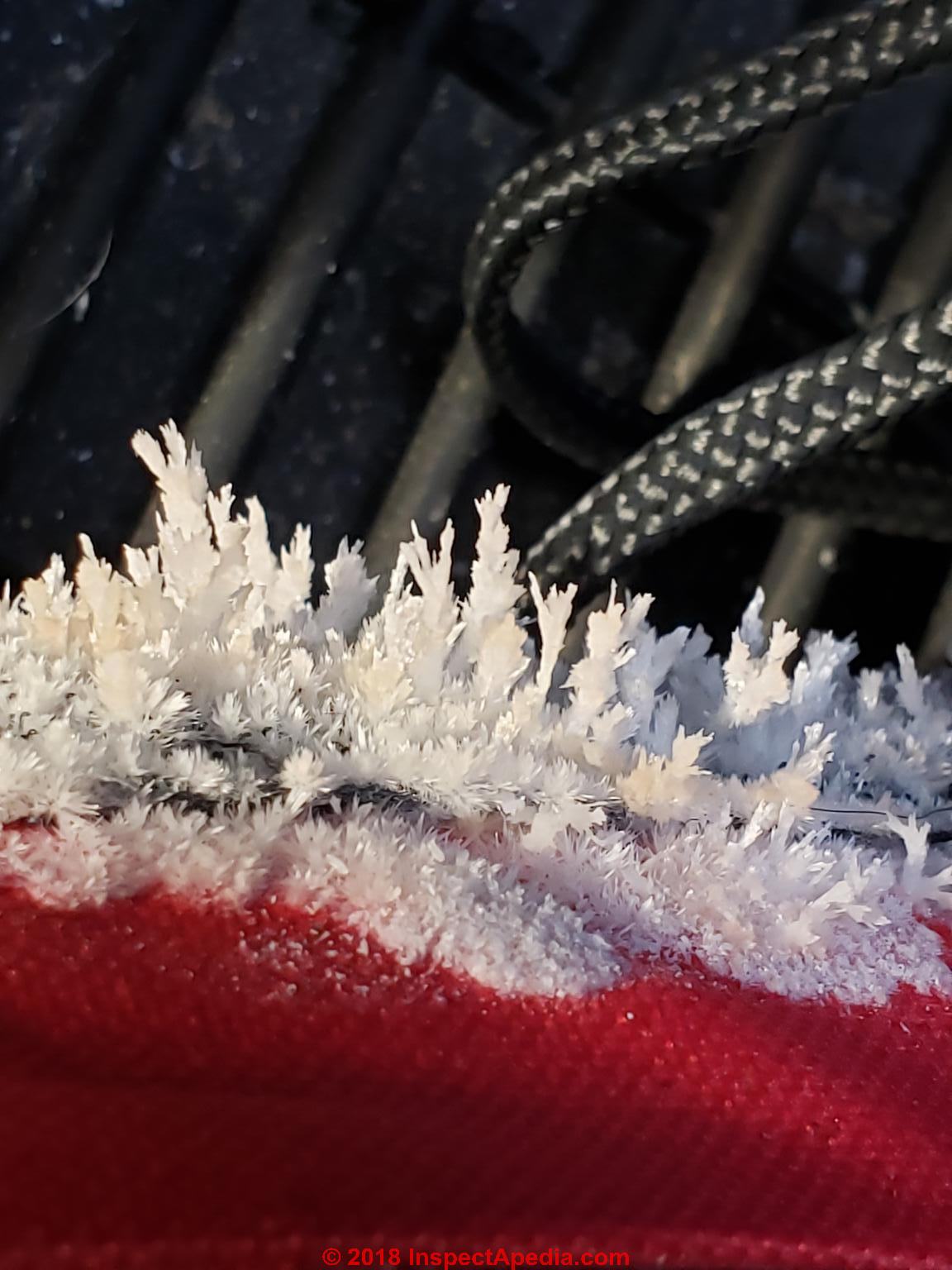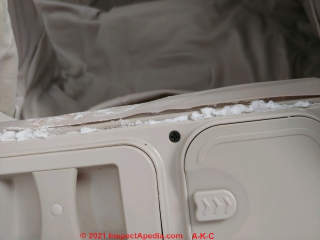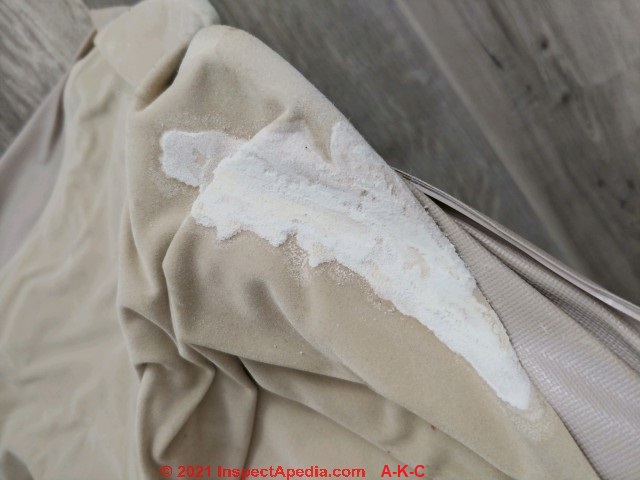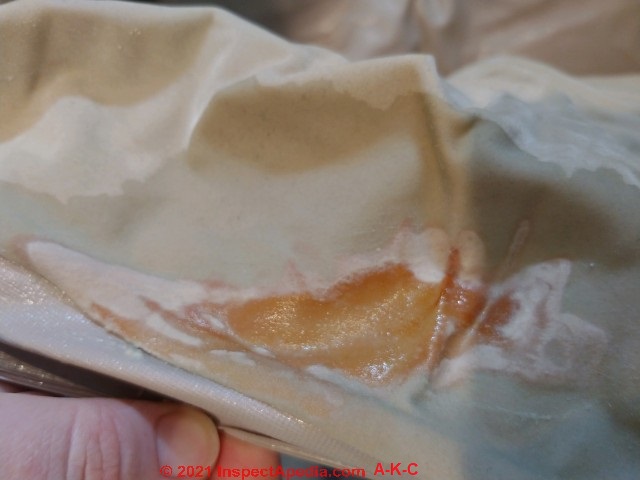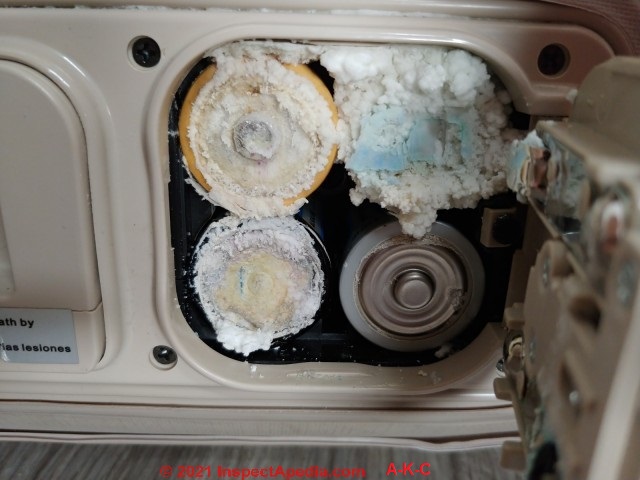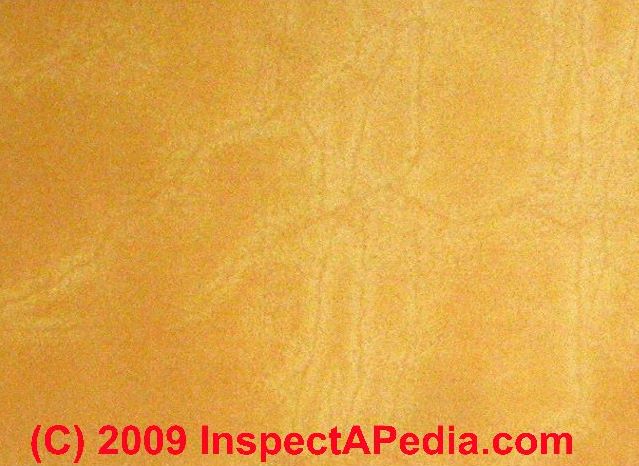 Mineral Efflorescence: Water Deposits
Mineral Efflorescence: Water Deposits
Efflorescence causes, cures, & significance in buildings
- POST a QUESTION or COMMENT about white & brown building stains & deposits: efflorescence causes, significance, cures
White efflorescence salts or stains on building surfaces: foundations, walls, walks, drives, and clay, concrete, or slate roofs form a fuzzy or crystalline deposit that indicates moisture or dampness problems.
For these white deposits we give the causes, cures, & their significance in buildings and we include diagnostic & identification photographs.
What does efflorescence mean as an indicator of moisture problems in buildings?
This article series illustrates and explains white or sometimes reddish brown bubbly surfaces on walls and white powdery or crystalline deposits left on walls, especially masonry walls, by moisture - efflorescence. Our photo at page top shows white fluffy crystals of mineral efflorescence near the bottom of a poured concrete foundation wall.
Note: for those of us who are not great spellers, this word is often mis-spelled as effloresence or as effloresents or other versions. In most of our text we'll use the proper spelling.
InspectAPedia tolerates no conflicts of interest. We have no relationship with advertisers, products, or services discussed at this website.
- Daniel Friedman, Publisher/Editor/Author - See WHO ARE WE?
How to Identify Efflorescence - Mineral Deposits (not mold) on Building Foundations and Masonry Walls or Chimneys
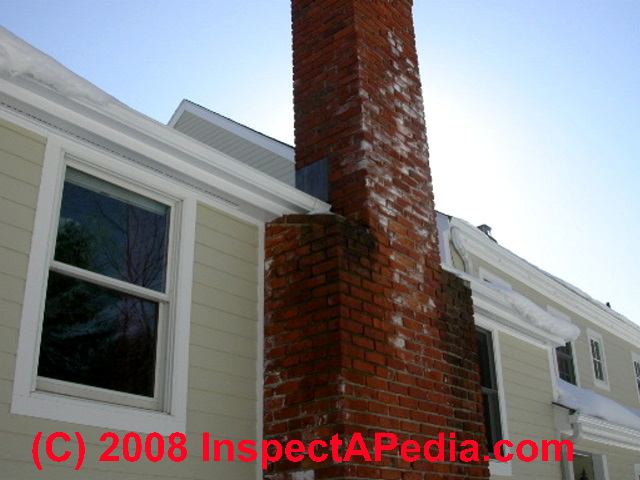 When investigating a building for a leak, water entry, or mold problem, you can save mold test costs by learning how to recognize Stuff that is Not Mold or is only Harmless Mold but may be mistaken for more serious contamination - save your money.
When investigating a building for a leak, water entry, or mold problem, you can save mold test costs by learning how to recognize Stuff that is Not Mold or is only Harmless Mold but may be mistaken for more serious contamination - save your money.
But it is important to recognize efflorescence as an indicator of the moisture or water flooding or leak history of a building because those conditions in turn can cause costly damage, mold contamination, or other unhappy conditions.
Our photo above shows white efflorescence on the outside of a masonry chimney - discussed separately
Here we discuss: mineral efflorescence - a substance often mistaken for but that is not is not mold.
We describe how to diagnose powdery white blotches on a painted stucco exterior wall - Stucco Bloom. How to identify signs of moisture or water entry in buildings & signs of high moisture.
Although efflorescence and mineral salts left behind by water are not mold they mean that mold-friendly conditions are present in the building.
How old is the efflorescence and how long does it take for efflorescence to form? Efflorescence = efflorescence = efforfescense = efflorescence if you're spelling efflorescence wrong.
Article Contents
- EFFLORESCENCE: WHAT IT LOOKS LIKE IN or ON BUILDING FOUNDATIONS, WALLS, CHIMNEYS
- EFFLORESCENCE: WHITE DEPOSITS on ROOFS - separate article
- EFFLORESCENCE: WHAT IS IT ?
- EFFLORESCENCE: USE LIGHT TO SEE IT
- EFFLORESCENCE UNDER the MICROSCOPE: IDENTIFICATION
- EFFLORESCENCE: IMPLICATIONS for BUILDING CONDITION & SAFETY
- EFFLORESCENCE AGE: HOW OLD IS IT?
- EFFLORESCENCE vs MOLD: HOW TO TELL THE DIFFERENCE
- EFFLORESCENCE CRYSTALS from CHEMICALS & SALTS
- EFFLORESCENCE: DEPOSITS from LEAKY BATTERIES
- EFFLORESCENCE: WHITE BLOOM in STUCCO WALLS & PAINTS
Appearance of Efflorescence: What is the White Fluffy Stuff on Building Walls or Roofs?
Just above we show very typical efflorescence deposited on a concrete block crawl space wall.
The location of these deposits is significant: efflorescence high on the walls of this crawl space suggests that the problem originates outside with roof runoff spilling by the foundation wall.
Take a look at the relation between the efflorescence marks and the height of soil against the wall and look for gutters spilling by the foundation or in-slope grade around the building.
Efflorescence or "mineral salts" is a whitish crystalline or powdery deposit on damp masonry walls, especially foundation walls which are located below ground level. Our photo (at left) shows a less serious case of white deposits on a concrete block foundation wall - white wall deposits at the mortar joints.
This usually-white fluffy material is efflorescence, a crystalline mineral salt left behind as moisture comes through the wall and evaporates into the building interior.
Efflorescence is not mold, though it is an indicator of wet conditions that could contribute to a mold problem somewhere in the building.
Efflorescence can vary in its chemical composition and therefore its color too. Reported since 1877, these salts leach out of brick, concrete, concrete block, stucco, and in some cases even stone. The salts that you see have been left deposited on the surface as water evaporates.
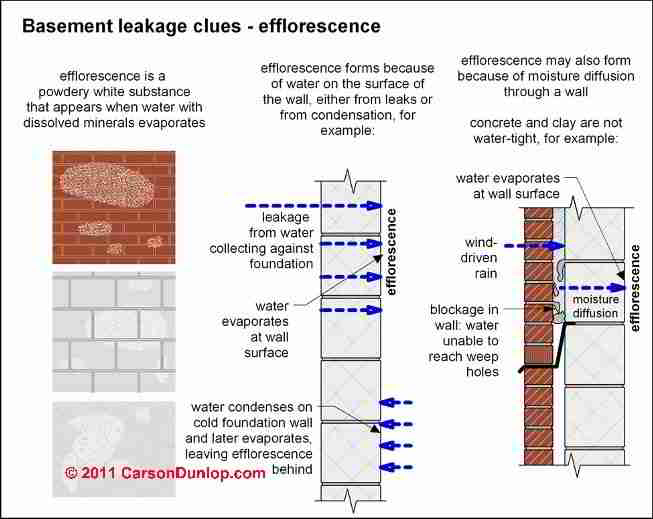
Carson Dunlop Associates ' sketch illustrates how efflorescence is deposited on building interior walls.
[Click to enlarge any image]
What's in White Efflorescence?
Multiple kinds of mineral salts (chlorides, nitrates, vanadium, chromium and molybdenum) may be present in efflorescence material, depending on the masonry or stucco composition).
Vanadium salts, common in clay or brick products from some areas such as Southwestern U.S., may produce green efflorescence on white or buff burned clay surfaces.
Other efflorescence salts leave white or gray deposits.
Above we see loose bulging paint and finally white mineral salts of efflorescence on a masonry wall. In looking for the moisture source that explains this paint damage and the white deposit the occupant reports a possible air conditioning system condensate drain leak above the area where this damage was seen.
Various descriptions of this efflorescence, often seen on concrete, brick, or concrete block chimneys, walls or foundations (either indoors or outside) are provided in the list just below. Readers should also see the brown wall, ceiling, or chimney deposits are discussed further
at EFFLORESCENCE & BROWN DEPOSITS .
- white fibrous substance on concrete block foundation wall
- white or tan fluffy or brown deposit on brick, stone, or cinder block walls, foundations, or chimneys
- spiky or fibrous substance on a wall
- white cotton-like substance on the foundation wall or on a plaster wall
- light white or tan crystalline substance
- white mold that looks at first glance like "dryer fluff", polyfill or fiberglass.
- white powdery deposits on stucco exterior walls - stucco bloom
- white or brown or reddish brown bubbly or fuzzy stuff "growing" on a plaster, concrete, concrete block, cinder block, or brick wall or on a masonry chimney
- light green or gray fluffy material on a brick or clay surface
- Yellow or brown bubbly crust material seen on plaster and on painted masonry block surfaces
Reader Question: Is the white stuff in this picture efflorescence?
I would appreciate your opinion on whether the attached photo is most likely efflorescence.
Thank you for your time - J.L.
You may use the attached photo for your website if you wish. If it is efflorescence then I think my photo might be better than the one you presently have.
Reply: Yes.
Thanks for the question & photo, J.L.
Yes this looks like and most likely is indeed mineral efflorescence, though I can't be completely certain from just the photo.
The white crystalline filamentous material is reflective, shiny, and appears to be "growing" up thorough a painted surface.
There are some white molds that also produce white filamentous growth, but I wouldn't expect them to be shiny and reflective as is your photos
(I've cropped and enlarged a central portion of your image - click to see an enlarged version of photos at InspectApedia).
Since efflorescence is basically a crystalline salt left behind as moisture evaporates through and off of a surface, you can expect it to be shiny, reflective, and fragile, crushing to a fine powder or dust under a fingertip.
As we explain in these articles, you can vacuum or wipe away the material, but unless you correct the underlying moisture source, just as with mold growth, it is likely to return rather soon.
Using Light to Inspect or Recognize Mineral Efflorescence
Let's look at typical white efflorescence more closely. Below are some examples of efflorescence on a masonry block wall that I inspected in New York.
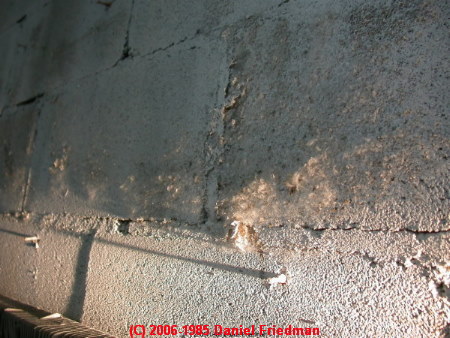 ...
...
by shining our light along the surface of this concrete block foundation wall we made the mineral salt efflorescence fluffy stuff show up clearly and we show how it grows "out" from the wall surface. (Photo, above )
Looking at this material with a low power magnifying glass you can easily see that it is hairy and even crystalline (photo above ).
Above and below we show how using your flashlight by shining it along the floor where water stains and white stuff is evident can make white efflorescence salts leap into clear view.
This is the same home whose downspouts are spilling around the foundation that we discuss
at EFFLORESCENCE: IMPLICATIONS for BUILDING CONDITION & SAFETY .
Mineral Efflorescence Under the Microscope
Here is a photo of efflorescence (mineral salt) which we collected from the wall (above) using clear adhesive tape, so you can see the appearance of mineral salts left behind by water leaking through a masonry block wall.
We used a low power stereoscopic microscope to see what this stuff looked like but it was not very informative so we decided to take a closer look using our Polam high-power light microscope.
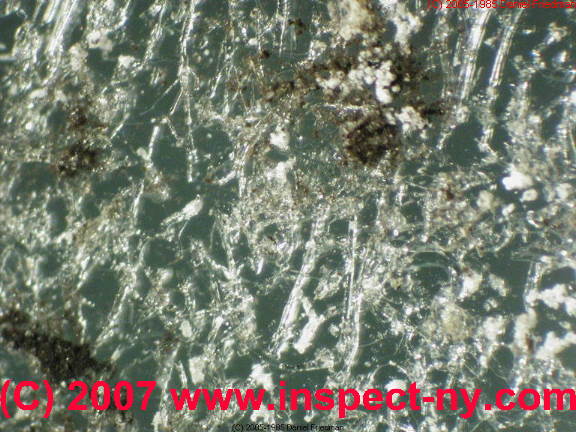
Here's the same tape sample of efflorescence under the high power microscope at about 100x.
You can see the crystalline structure of this substance in the long, translucent fibers. The black stuff is dirt from the wall surface.
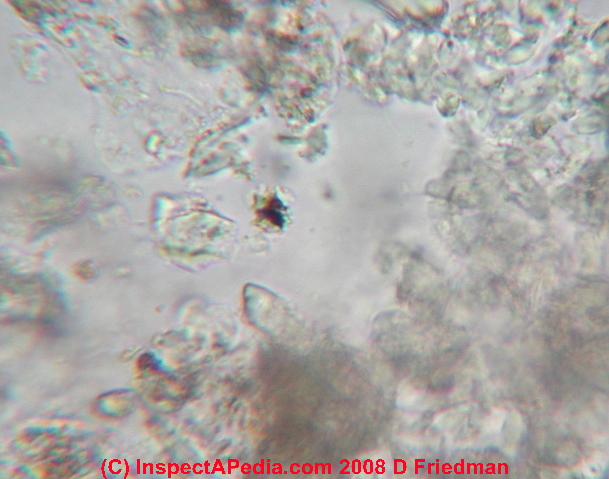
Shown just above and below are two high-magnification microscopic photographs of efflorescence (mineral salts) which we took at 720x in our lab.
This efflorescence sample was collected as "white powdery or cottony stuff on the foundation" by our client. It's easy to see that this is a mineral like substance, crystalline. It is not organic, not mold.
Below are two more microphotographs of larger particles of mineral efflorescence taken in our lab at 480x (4/19/10). The first image is in transmitted light.
Below our image of the same particle shown above uses cross-polarized light to demonstrate a mineral quality of the substance.
On the sample tape the material appeared as a white and light lemon-yellow powdery substance.
What Does it Mean to Find Efflorescence and Stains in a Building Interior?
Interior or exterior efflorescence found on building surfaces (virtually always masonry or some kind of painted or coated masonry) means that there are wet conditions at the property.
See details of possible building damage from efflorescence now
at EFFLORESCENCE BUILDING DAMAGE
How Old is the Efflorescence on a Building Surface & How Quickly Can Efflorescence Form?
Can we Determine the Age of Efflorescence on a Building
I would like to know the typical length of time that is necessary for a crystal-like efflorescence thing in my photos to develop. I was told that it would take "years". I believe mine developed over a period of 3-6 months. Is that possible? Thank you again.
Background: I have spent nearly $4000 on a water intrusion situation that is no where near resolved. We live in the Dallas, TX metro area. Our property experienced a 3+ month long recurring city water main break beginning in Oct 2009.
During this time period I discovered mold growing all over household items and furniture. It was not until Feb. 1, 2010 that I looked in crawl space and discovered standing water on top of plastic vapor barrier.
For the last three months I have consulted dozens of local experts, including engineers, foundation and drainage companies. My home owners policy rejected my claim as it was a city line that broke. The city insurance rejected my claim saying they have "governmental immunity".
Prior to the flooding event I have lived in this home for 13 years with no problems. It has only been since the city water main break that we have had these issues. The final repair to city line was completed in January.
My crawl space has been so wet that no one will venture under there.
In April we installed an open face surface drain to catch roof and surface water to see if that would help.
Even after this modification it now seems that with each subsequent rain event that more water is entering the crawl space. we are at my wits end and have about run out of funds to address this problem.
I have been in contact with my city council person and my goal is to try and get the city to help remediate this mess. I have a difficult task of "proving" to them that they are responsible for this.
I believe the city water leak put so much pressure against my perimeter concrete foundation that what we are looking at is a form of efflorescence, rather than a fungus suggested by a city worker.
Notice the weird staining patterns behind the crystal thing. Would you be willing to comment about what you see in these photographs? - S.M.
Reply
OPINION - is it Efflorescence?: It is pretty easy to distinguish between mold and efflorescence, as photos on this page show.
Efflorescence is a crystalline mineral salt. It looks crystalline under magnification, even low magnification. The photo at left gives an idea of the typical size & scale of mineral efflorescence formed on a building surface.
Mold is an organic growth and certainly does not look like crystals.
See MOLD APPEARANCE - WHAT MOLD LOOKS LIKE .
If necessary, a simple tape lift of surface material can let a laboratory confirm whether or not the substance you are seeing is mold or efflorescence
Watch out: the same conditions that produced efflorescence mean that there has been high moisture or even water in the building, just as you described above.
So where efflorescence is found in a building, mold contamination may be present in the same or even other building areas (moisture travels upwards through a building from a wet basement or crawl area.) In addition to checking for mold contamination, it is very important to dry out the crawl space and keep it dry.
See our guidance on crawl spaces
at CRAWL SPACES .
OPINION - how old is the efflorescence?: Age of efflorescence: we don't agree that "years" are necessary before efflorescence becomes visible on a building surface.
The photographs shown above (mineral efflorescence around as single loose stone tile in a floor or wall - in this photo a new shower enclosure) may have been of an old condition, but as we have found such stains on homes just a year or two old, and we have found efflorescence appearing in days after a leak or flooding event in a building.
Clearly the rate of formation of mineral salt efflorescence on a surface depends on local conditions and a number of more technical variables.
The lack of extensive rust or stains on other crawl surfaces argues that the water intrusion may be more recent than the age of the home.
Basically to find efflorescence on a building surface we need moisture wicking through masonry, then evaporating off of the surface to form effloresence.The rate of deposition of crystals probably depends on the level of soluble salts in the masonry through which water is moving, the level of other dissolved minerals in the water, other water chemistry factors, the extent and frequency of water source.
All of that technical depth is beyond our expertise. But in general, we would not be surprised to see white stains on a masonry block wall in 6-months to a year if conditions are right.
Some moisture stains and efflorescence do have an older look, a sort of crust, that seems to form after a longer time of wet and dry cycling.
It's an interesting question - let's hear from some masonry chemists. CONTACT us if you have more information on efflorescence age.
Watch out: while we are sure that efflorescence can form on a masonry surface within months under the right conditions, don't mistake "old" efflorescence for "new". Some light efflorescence deposits can be quite old on a building wall.
But if you are sure that efflorescence satins on a surface did not have white efflorescence stains, yellow efflorescence stains, brown stains (as in our photo at left), tan efflorescence or stains at a particular time, and the material appeared more recently by your own observation, we agree that it is certainly accurate and reasonable that the correct assessment is that the efflorescence is new.
You may be able to sort out the age of efflorescence using some of the same thinking we use to sort out the age of mold: look for other evidence of the history of leaks or water entry such as other stains, or rot.
Example of rapid overnight growth rate of mineral efflorescence
I was just researching to find the cause of some white powdery growth that I found on my basement floor after a flood. I came across your article on this page: https://InspectAPedia.com/Wet_Basements/Efflorescence-White.php
Part of the article talks about how long it takes for efflorescence to grow. You estimated that it could grow in as little as 6 months and you asked people to contact you if they had information regarding growth rates. Well, I have info!
I live in Aurora, CO and we just had some historic flooding. Prior to this week, my basement was fairly dry. In the past 4 days, my basement has flooded three times with fresh rainwater that seeped through concrete foundation walls and then pooled on my concrete floor.
I was able to pump out and remove all visible water fully between each of the floods and I had fans going to dry the rooms out. I noticed the white stuff after the first flood and I sprayed it with Simple Green cleaner.
After the next flood, it was back and slightly worse. After the 3rd flood it was back and much worse. This time I sprayed with Clorox Cleanup with Bleach.
It can grow OVERNIGHT to a height over 1/2 inch. Sorry I didn't measure before spraying it with bleach! Upon contact with any form of liquid it disappears, so I'm guessing it really isn't mold as I had previously feared. Whew!
But I still don't know how to remove it. It looks scary and I don't want my tenants to think we have a mold infestation. I haven't tried scrubbing it yet... just spraying. It is snow white and grows up vertically in tiny strands.
It looks like incredibly fine hair. If you rub it between your fingers, then it turns into white powder.
I will now return to your site to read and learn more about this odd substance. Thank you for your great info! G.L. Aurora CO 9/17/2013
Reply: efflorescence is not a biological structure - no need to try to "kill" it with bleach; adding any moisture may increase efflorescence formation
Thank you for your note - indeed efflorescence can appear quickly, and indeed I owe the topic some citation of sources on growth rates - for which your own experience and report are very helpful - I'll add that information to our published data.
I did want to remind you immediately that using chlorine bleach is totally unnecessary when dealing with efflorescence.
Because efflorescence on masonry is a mineral crystal formation, it is not biological in nature: so "killing it" or "bleaching it" is both unnecessary and ineffective. In fact adding any evaporating liquid to the surface may simply increase the next rate of efflorescence formation.
Spraying the identical site with water, or soapy water, or any household cleaner would be equally effective in removing the material, but I do NOT recommend this approach because we are adding moisture and thus starting a new cycle of evaporation from the surface - which in turn pulls more moisture through the wall from a presumably wet or moist exterior side.
I'd prefer to HEPA vacuum or just wipe the surface.
If for cosmetic reasons we need to use a liquid cleaner, use as little as possible.
Ultimately the solution to efflorescence (which is not always economically feasible) involves removing the water source from the other side of the surface on which efflorescence is appearing or "growing"
Without that step, we can slow, but not halt, efflorescence formation by sealing the exposed or presumably interior masonry wall surface. by slowing evaporation from that surface we slow the pull of moisture through the wall, thus slowing the rate of efflorescence re-growth.
For efflorescence that appeared only in response to an indoor flood event such as a burst pipe, drying and cleaning the interior is the key step. Nonetheless efflorescence may reappear on the previously affected wall for a time, even in this case, if the wall structure itself has absorbed much moisture.
Bubbling Bulging Paint, Brown & White Deposits on Walls: is it mold or efflorescence
Because some clients have on occasion sent samples to our lab that really should not have been collected, much less looked-at, we provide this library of photographs of things that are "not mold" and don't need to be tested.
These are substances that you can easily learn to recognize in buildings. Save your mold test money, and increase the accuracy of your mold contamination inspection or test for toxic or allergenic mold in buildings: review these items to learn recognize non-fungal materials or even possibly harmless cosmetic "black mold" often mistaken for "toxic fungal growth."
So many people have written, sent photos, called, and even sent samples of efflorescence or other things that are not mold that we offering these pictures and information about white and brown deposits in buildings.
WARNING: Finding "not mold" material in a building does not mean that there is no mold or allergen problem.
Even relatively harmless house dust collected on a surface and sent to our lab as a mold screening test can contain a surprising amount of problematic mold spores if the building has a mold problem.
Mineral efflorescence is a sign of leaks into a building - leaks that might indeed produce a mold problem. But don't mix up efflorescence itself with mold.Save your money, don't bother testing mineral efflorescence nor the other stains we describe
at HARMLESS INDOOR PARTICLES .
What about white "growth" or stuff on walls, particularly masonry walls or plaster walls? You may be looking at efflorescence - which is not mold.
Bubbling wall surface, brown & white deposits, dusty: is this mold or efflorescence?
I was looking at your very good website because I found, when I was cleaning, some brown stains and painting bubbles/peel in the closet wall.
The bathroom is on the opposite side of that wall and you see on the photo that there are some piping there which I think are connected to the shower. When I scraped some of these bubbles I got some white powder like dust, however the concrete seemed to be dry with touch.
There are some bubbles and peeling in the bathroom (same wall) but concrete there seemed to be also dry with touch.
Do you think I have mold on my hand or just some stains which I can fix by scraping of the peeling painting and repaint?
Ps. The air humidity is normally 30-40% often nearer 30% mark.
Sincerely, S. - Iceland
Reply: Expect efflorescence on leaky masonry surfaces; expect mold on organic surfaces (wood, drywall, paper) when those surfaces have been wet
A competent onsite inspection by an expert usually finds additional clues that help accurately diagnose a problem such as the moisture source that has caused the wall damage in your photograph. And certainly we can't absolutely identify building materials by email and photos, but that said, your photo looks to me like mineral efflorescence and bubbling paint on a masonry wall.
So if the wall in your photo is solid masonry such as painted solid concrete, concrete block or stucco or cement over a masonry wall, we're most likely looking at mineral salts left behind as moisture evaporates from the wall surface.
Why Efflorescence Forms Paint Bubbles on a Painted Concrete Wall
The lifting power of the mineral crystals of efflorescence that form during moisture evaporation is quite strong, easily pushing paint off of the painted concrete wall to form the bubbly surface in your photo.
Take a closer look at that whitish or light yellow "powdery" material on the wall, using a magnifying glass and I expect you'll see that the material is crystalline - mineral efflorescence - not organic mold structures.
See the text in our EFFLORESCENCE article just above for more illustrations of mineral efflorescence Typically the problem comes from moisture leaking through masonry walls. I would not assume there is no mold in other areas of the the building however, particularly if you've had other leaks that wet more mold-friendly materials that support fungal growth such as wood, drywall, paper, carpeting.
More photos of brown and other colored deposits on masonry walls can be seen
at EFFLORESCENCE & BROWN DEPOSITS
Can Mold Even Grow on Masonry?
Most mold genera/species require organic material for food. In buildings that means mold-friendly materials include wood, drywall, paper, carpeting, paint, some plastics, cloth, and similar stuff. But indeed, we can on occasion see mold on a masonry surface, usually under one or both of the following conditions:
- The masonry wall is painted - the mold is growing really on the paint, not the masonry
- The masonry wall may be unpainted but has a coating of dust and debris that includes organic particles - we find this condition, for example, in a damp basement where dogs or other animals are kept
- On some buildings, usually outdoors, there are even some mold genera/species that will form directly on the masonry surface, though more often we find that stains are actually algae, not mold.
Relation of indoor humidity level and efflorescence formation on masonry walls
Finally, regarding your observation that "The air humidity is normally 30-40% often nearer 30% mark." - that's a pretty low indoor humidity level. But I'll bet that the location where you are measuring the relative humidity is not the surface of that bubbly stained wall, right?
Typically when I see a masonry wall that looks like the one in your photo I find a leak or water source outside the wall, one that is sending moisture through the wall.
The lower indoor humidity actually speeds the formation of efflorescent salts because the relatively dry indoor air helps speed moisture evaporation from the wall surface - leaving those salt crystals behind on the wall.
My advice: see if you can find and fix the moisture source that is causing the wall damage from efflorescence in your photo.
White Crystalline or Powdery Deposits from Chemicals
White crystalline growth on roadside emergency bag containing flares.
Found these white crystals growing on a road side emergency bag I have under my back seat.
It did not feel wet, I opened it up and the flares and everything else seemed just fine, also no crystals inside. I was thinking salt or mold but it's just localized to that one spot. Any idea on what this is? - 2019/01/02
This Q&A were posted originally
at MOLD APPEARANCE - STUFF THAT IS NOT MOLD
Reply: crystalline growth or deposits from chemicals, flares, leaky batteries
I agree that the material looks like crystals, not a fungus.
If you look inside the bag and see no deposits whatsoever in the corresponding area of the fabric then one would think that some salt or chemical (perhaps from a leaky flare) got onto the fabric.
I've seen similar white crystalline growth at battery terminals, at leaky batteries (shown below), at old (and unsafe) road flares, and from other chemicals.
The surrounding surfaces may indeed appear to be and are actually rather dry.
Most roadside flares are comprised of strontium nitrate, potassium nitrate, or potassium perchlorate, mixed with a fuel substance as simple as powdered charcoal or possibly sawdust, along with aluminum, magnesium, or a polymeric resin.
The aluminum or magnesium provide extra energy to produce a very bright and faster-burning combustion when the flare is ignited.
Emergency flares are packaged in a moisture-resistant container and resist deterioration and chemical leakage, but the combination of age and vibration as they spend their life waiting in a roadside emergency bag along with exposure to high storage temperatures when left in a close vehicle can still take its toll on the flare's life and lead to leaks that might explain the crystals in your photo.
Watch out: such crystals from a battery leak or roadside emergency flare leak may be chemically active and harmful, particularly if you get the material in your eyes.
Similar white or gray crystals are found on terminals of vehicle batteries and at the cases of leaky flashlight batteries. Those crystals are typically a goopy mess of water and ammonium chloride or zinc chloride.
Perchlorate Hazard Research & References
- Duncan, P. Brent, Robert D. Morrison, and Emily Vavricka. "Forensic identification of anthropogenic and naturally occurring sources of perchlorate." Environmental Forensics 6, no. 2 (2005): 205-215.
- Federman, Jane H., and Joseph J. Sachter. "Status asthmaticus in a paramedic following exposure to a roadside flare: A case report." Journal of emergency medicine 15, no. 1 (1997): 87-89.
- Finkelstein, Don B. "Pyrotechnic flare." U.S. Patent 3,051,085, issued August 28, 1962.
- Herman, Zelek S. "Ionic crystals: A simple and safe lecture demonstration of the preparation of NaI from its elements." Journal of Chemical Education 77, no. 5 (2000): 619.
- Ling, L. I. BIODEGRADATION OF PERCHLORATE [PDF] (term paper) retrieved 2019/01/02 original source http://home.eng.iastate.edu/~tge/ce421-521/termpaper%20by%20Ling%20LI.pdf
- Orion Safety Products, RED EMERGENCY FLARE MSDS (NPC) No Perchlorate formula , [PDF] Orion Safety Products, 28320 St, Michaels Rd., Easton MD 21601 USA, retrieved 2019/01/02 original source https://www.forestry-suppliers.com/Documents/2255_msds.pdf
800-6,37-7807
Excerpt from Orion:
Flares are a safe and stable item to store. The U.S. Departments of Transportation classifies flares as a flammable solid, but they are not particularly sensitive to initiation. There is no threat of mass explosion, nor is there any threat of an individual flare exploding.
Flares should be stored in sealed bag, away from flame and heat. Failure to store in sealed bag will diminish flare performance.
While flares have no expiration date when properly stored, storage above 120 degrees F for a long period of time (more than 1 week) should be avoided.
The normal recommended storage temperatures are 40 degrees to 90 degrees F. - http://www.orionsignals.com/faqs/faqs-on-proper-emergency-flare-usage.html- US GSA REMOVING SOLUBLE SALTS from LIMESTONE [PDF] U.S. General Services Administration, retrieved 2020/12/14 original source: https://www.gsa.gov/ technical-procedures/ making-solution-removing-beverage-soot-tar-and-other-stains-concrete? Form_Load=88075
- US GSA REMOVING SALTS / EFFLORESCENCE from BRICK & STONE MASONRY [PDF] U.S. General Services Administration, retrieved 2020/12/14 original source: https://www.gsa.gov/ technical-procedures/ making-solution-removing-beverage-soot-tar-and-other-stains-concrete?Form_Load=885
Leaky Battery Deposits: White Powdery Substance is Unsafe
Not all fluffy white or powdery-white deposits that look like the white mineral efflorescence shown
at EFFLORESCENCE SALTS & WHITE DEPOSITS are caused by mold nor by moisture.
Shown here are white crystalline deposits found on an inflatable air mattress after it had been stored for over a decade. We describe the procedure of cleaning off this contaminant and of identifying its cause. We also discuss safety concerns when cleaning up unknown white fluffy or crystalline deposits.
The air mattress shown in these photos (courtesy of technical contributors A&K C.) was stored folded-up for at least ten years, having spent most of its life in the dry climate of Arizona before being unpacked in northern Minnesota.
You might guess that this looks like mineral efflorescence, but to form mineral efflorescence, we need a mineral or a masonry material (bricks, stone, concrete) plus moisture.
[Click to enlarge any image]
You can easily determine that this material is not mold by its physical appearance as white crystalline or needle-like structures.
So by appearance we were confident that this would not be mold and though it looked like efflorescence, the field investigators looked further for some other source of leakage or contamination.
Was the mattress stored in an area where it was exposed to flooding? No. Perhaps it was exposed to a spill or leak of some contaminant while in storage? No. The bag in which the mattress had been stored showed no stains or signs of having been exposed to an external source of contaminant.
The investigators set out to clean the deposits and then to further unfold the stored air mattress. They used spray glass cleaner and paper towels and a soft brush to clean off the white deposits, taking care to protect skin and eyes from the unknown deposits.
They noticed that where the contaminant had leaked onto the felted surface of the air mattress, the fibres were destroyed, leaving the plastic base of the fabric: a clue that the salts were probably caustic or acidic (and possibly unsafe).
And where cleaned off, the white deposits left a discolored surface.
Further unfolding the air mattress quickly led to the cause of these white fluffy crystalline deposits: battery acid leaks were extensive in the battery compartment for that air mattress
Leaky batteries, including alkaline D or C cells, A sized batteries and even smaller batteries can leak due to age, storage conditions, or misuse.
Leaky batteries damage the electrical components or even simply the battery compartment in which they were stored, principally by corrosion.
Further clean-up using a damp cloth and optionally a baking soda solution to further neutralize the acid was in order. In this case however, since the extent of damage to the electrical components was unknown, the air mattress was disposed of and a new one purchased.
Watch out: Seeping electrolyte leaking out of batteries is principally potassium hydroxide (KOH), a caustic that can burn the skin or could cause serious eye injury if it gets into someone's eye. Take care to avoid getting battery acid or salts left behind by a leaky battery in your eyes. Wash your hands and any exposed clothing thoroughly.
Avoid leaky battery damage by removing batteries from your battery-operated device before storing it for an extended period.
What Causes Powdery White Blotches or Mottling in Paint on a Stucco Exterior Wall? Stucco Bloom.
Our photo above shows white blooming efflorescence and mottling appearing on painted stucco after less than a year of application of paint onto a new stucco exterior wall in the Southwestern U.S.
See PAINT on STUCCO, FAILURES for details of paint failure diagnosis on stucco surfaces.
We also discuss efflorescence as a type of paint problem
Painting over cracks where moisture has not fully evaporated or painting over a new stucco wall too soon and where the wall pH or alkalinity remains too high (over 11) can lead to both cosmetic problems as well as early wear or failure of the painted coating.
The application and curing procedure used for stucco, in turn affect the wall pH - it needs to be tested by the painter before the paint job begins.
Cause & Remedy for White Efflorescence on Exterior Masonry Walls
To clean off efflorescence, see our advice
at EFFLORESCENCE REMOVAL & PREVENTION - What steps should I do to remove efflorescence from my building?.
White Efflorescence on Clay, Concrete Tile or Slate Roofs
This discussion has moved
to EFFLORESCENCE: WHITE DEPOSITS on ROOFS
...
...
Continue reading at EFFLORESCENCE REMOVAL & PREVENTION or select a topic from the closely-related articles below, or see the complete ARTICLE INDEX .
Or see EFFLORESCENCE SALTS WHITE DEPOSITS FAQs - questions and answers about white efflorescence that were posted originally on this page.
Or see these
Recommended Articles
- EFFLORESCENCE SALTS & WHITE DEPOSITS
- EFFLORESCENCE BUILDING DAMAGE
- EFFLORESCENCE & BROWN DEPOSITS
- EFFLORESCENCE REMOVAL & PREVENTION
- EFFLORESCENCE: WHITE DEPOSITS on ROOFS
- MOISTURE CONTROL in BUILDINGS
- MOLD APPEARANCE - STUFF THAT IS NOT MOLD
- MOISTURE CONTROL in BUILDINGS - home
- STAIN DIAGNOSIS on BUILDING INTERIORS - home
- STAINS on BRICK SURFACES
- STAINS on CONCRETE
- STAIN DIAGNOSIS on BUILDING EXTERIORS - home
- STAINS on SANDSTONE, DIAGNOSE & CURE
- STAINS on STONE, STUCCO DIAGNOSE & CURE
- WATER ENTRY in BUILDINGS
- WHITE MOLD PHOTOS - is it mold or efflorescence: in this case it's a fungus or a white or light coloured mold growing in buildings.
- WHITE STAINS on ROOFS - home
Suggested citation for this web page
EFFLORESCENCE SALTS & WHITE DEPOSITS at InspectApedia.com - online encyclopedia of building & environmental inspection, testing, diagnosis, repair, & problem prevention advice.
Or see this
INDEX to RELATED ARTICLES: ARTICLE INDEX to BUILDING STAINS
Or use the SEARCH BOX found below to Ask a Question or Search InspectApedia
Ask a Question or Search InspectApedia
Questions & answers or comments about white & brown building stains & deposits: efflorescence causes, significance, cures.
Try the search box just below, or if you prefer, post a question or comment in the Comments box below and we will respond promptly.
Search the InspectApedia website
Note: appearance of your Comment below may be delayed: if your comment contains an image, photograph, web link, or text that looks to the software as if it might be a web link, your posting will appear after it has been approved by a moderator. Apologies for the delay.
Only one image can be added per comment but you can post as many comments, and therefore images, as you like.
You will not receive a notification when a response to your question has been posted.
Please bookmark this page to make it easy for you to check back for our response.
IF above you see "Comment Form is loading comments..." then COMMENT BOX - countable.ca / bawkbox.com IS NOT WORKING.
In any case you are welcome to send an email directly to us at InspectApedia.com at editor@inspectApedia.com
We'll reply to you directly. Please help us help you by noting, in your email, the URL of the InspectApedia page where you wanted to comment.
Citations & References
In addition to any citations in the article above, a full list is available on request.
- Thanks to reader S.M. (anonymous by request) for discussing the rate of formation of efflorescence, May 2010
- In addition to citations & references found in this article, see the research citations given at the end of the related articles found at our suggested
CONTINUE READING or RECOMMENDED ARTICLES.
- Carson, Dunlop & Associates Ltd., 120 Carlton Street Suite 407, Toronto ON M5A 4K2. Tel: (416) 964-9415 1-800-268-7070 Email: info@carsondunlop.com. Alan Carson is a past president of ASHI, the American Society of Home Inspectors.
Thanks to Alan Carson and Bob Dunlop, for permission for InspectAPedia to use text excerpts from The HOME REFERENCE BOOK - the Encyclopedia of Homes and to use illustrations from The ILLUSTRATED HOME .
Carson Dunlop Associates provides extensive home inspection education and report writing material. In gratitude we provide links to tsome Carson Dunlop Associates products and services.


